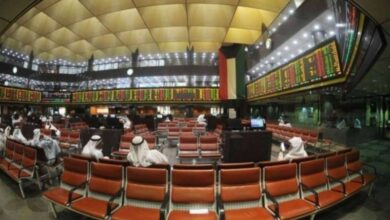Kuwait’s economic path shows strengths shine amid future hurdles
Kuwait, classified as a high-income country due to its oil wealth and high per capita income, is projected to experience modest economic recovery with GDP growth of 3.7% in 2025 and 3.3% in 2026, along with expected government revenues of $135 billion in 2025.

• Kuwait’s economy is projected to see a 2.6% inflation rate in 2025, with 15% of GDP attributed to gross public debt last year and 30% of GDP contributed by non-oil sectors in the first half of the year.
• Inflation in Kuwait has remained moderate due to government subsidies, and GDP growth is expected to offset the impact of reduced OPEC+ production quotas in 2025 and 2026.
• Government revenues are expected to rise to $135 billion in 2025, up from $130 billion in 2024, while public debt is projected at 15% of GDP, compared to 14% in 2022 and 2023.
The 2025 edition of the World Economic Conditions and Prospects (WESAP) report, published annually by the United Nations Department of Economic and Social Affairs, offered mixed assessments of the Kuwaiti economy. The report provides a comprehensive analysis and future forecasts of economic and trade challenges and opportunities across approximately 190 countries, evaluating their past and projected growth rates, according to Al Rai newspaper.
Noting that Kuwait is classified as a “high-income” country, the report attributed this status to its substantial oil wealth and relatively high per capita gross national income.
Limited recovery in Kuwait’s economy
According to the report, the 2024 figures indicate a limited recovery in Kuwait’s economy, with an official forecast of 2.8% annual growth for the year. Further improvement is expected in 2025, with growth projected at 3.7%. The report highlights that Kuwait’s real gross domestic product (GDP) experienced modest recovery in 2024, with growth rates projected at 2.6% in 2025 and 3.3% by 2026.
Financially, the report anticipates a shift in Kuwait’s budget from an expected fiscal surplus in 2024 to a fiscal deficit in 2025 and 2026. Government revenues are expected to rise in 2025, reaching approximately $135 billion. Meanwhile, the total public debt as a percentage of GDP is estimated at about 15% for 2024. Regarding the contribution of non-oil sectors to GDP, the report noted a 30% contribution during the first half of 2024, with a similar percentage expected for the second half.
The report also predicts a slight increase in Kuwait’s Consumer Price Index (CPI) in 2025, reaching 113.7 points compared to 112.3 points in 2024. Inflation rates have remained relatively moderate and controlled over the years, thanks to government subsidies on energy and food prices, which shield consumers from global price shocks. Additionally, the expected growth of Kuwait’s GDP is likely to mitigate the impact of reduced OPEC+ production quotas in 2025 and 2026.
In comparison to the economies of other Gulf countries, the report highlights both the strengths of Kuwait’s economic growth path and the challenges it faces in the future.
The following details highlight the most prominent economic data and forecasts related to Kuwait from the report:
Gross (and real) output: The report projected that Kuwait’s GDP growth will rise to 3.3% in 2025 and 3.7% by 2026, up from 2.6% in 2024. It noted that GDP growth was -3.6% in 2023, following a peak of 5.9% in 2022. Real GDP growth rates have exhibited a fluctuating pattern over the past decade. For instance, between 2016 and 2023, Kuwait’s economy alternated between periods of growth and contraction. The largest contraction, -4.8%, occurred in 2020 due to the economic disruptions caused by the COVID-19 pandemic.
Regarding expected real GDP growth, the report suggested it could increase to 3.7% by 2025 from 2.6% in 2024, with a potential rise to 4% in 2027 based on prevailing economic trends, though this trend is not yet evident.
Financial deficit: The report indicated that Kuwait’s budget is expected to shift from a financial surplus achieved in 2024 to a financial deficit in 2025 and 2026. The projected deficit is attributed to significant investments planned under the “Kuwait Vision 2035” initiative, as well as the financial requirements of government support programs for citizens.
Government revenues: Government revenues are estimated to increase in 2025, reaching approximately $135 billion, compared to $130 billion in 2024, $120 billion in 2023, and $110 billion in 2022.
Public debt: The report estimated the total public debt as a percentage of GDP at 15%, compared to 14% in 2022 and 2023, respectively.
Non-oil contribution: Regarding the contribution of non-oil sectors to GDP, the report indicated that this share amounted to 30% in the first half of 2024. The percentage for the second half of the year has not yet been announced, but it is expected to increase gradually during 2025 and beyond. The report also noted that the average contribution of non-oil sectors to GDP was 25% between 2010 and 2014 and 28% from 2015 to 2019.
Kuwait’s consumer price index: In its analysis and forecasts of Kuwait’s Consumer Price Index (CPI), the report projected a slight increase in 2025, reaching 113.7 points, compared to 112.3 points in 2024 and 110.9 points in 2023.
The CPI measures the monthly, quarterly, and annual changes in the prices of a specific basket of consumer goods and services, including food, clothing, and transportation. It serves as the primary indicator of inflation and is often referred to as the cost-of-living index.
Inflation rates: The report predicted that Kuwait’s inflation rate would reach 2.6% in 2025. Historically, inflation has ranged from a low point in 2018 to a peak in 2022 before stabilizing at 2.8% in 2024.
The report explained that inflation rates have remained relatively controlled over the past few years, supported by the following data:
In 2024, inflation stabilized at 2.8%, supported by energy and food subsidies as well as related fiscal policies. In 2022, inflation peaked at 4%, driven by surging global food and energy prices following the outbreak of the Russia-Ukraine conflict and in 2018, inflation reached its historic low of 0.5%, attributed to global deflationary pressures at the time.
Oil production: In its forward-looking analysis of the drivers of Kuwait’s economic growth, the report indicated that the projected growth of Kuwait’s GDP is likely to help mitigate the anticipated negative effects of OPEC+ production quota cuts during 2025 and 2026. This growth is expected to strengthen financial conditions despite the forecasted deficits for both years.
Comparison to economic growth of Gulf countries: When comparing the expected economic growth rates of Gulf countries, the report projected a significant increase in overall growth, reaching 4% in 2025, up from 1.7% in 2024, with a slight rise to 4.5% in 2026. The report highlighted that Kuwait’s economic growth path features both strengths and challenges along the following two axes:
- Kuwait’s projected GDP growth for 2025 is 2.6% lower than the strongest expected performances of Saudi Arabia and the UAE.
- Kuwait has demonstrated strength in controlling inflation rates more effectively than its Gulf counterparts, reflecting the success of its fiscal policies.













